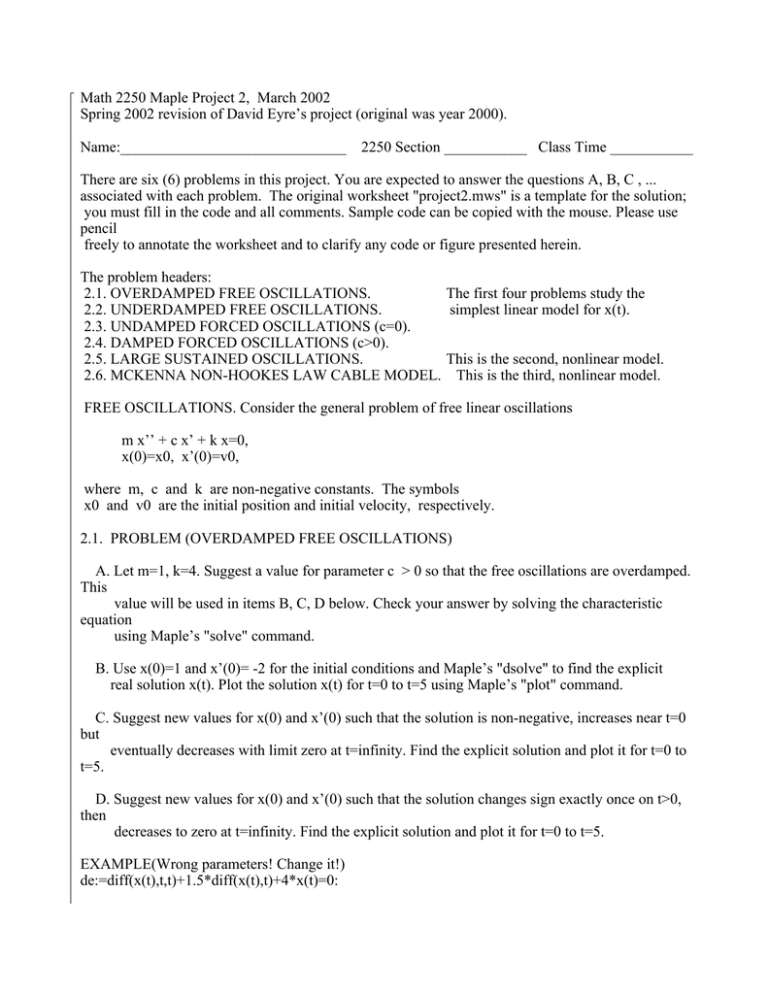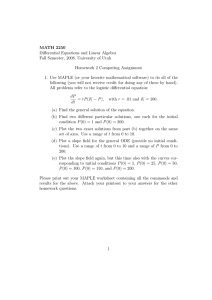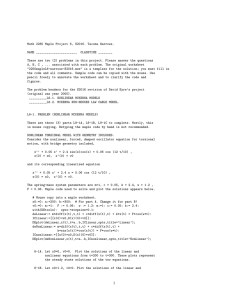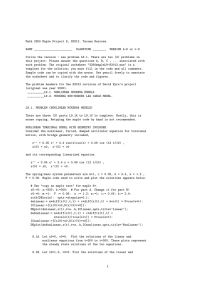Math 2250 Maple Project 2, March 2002
advertisement

Math 2250 Maple Project 2, March 2002
Spring 2002 revision of David Eyre’s project (original was year 2000).
Name:______________________________
2250 Section ___________ Class Time ___________
There are six (6) problems in this project. You are expected to answer the questions A, B, C , ...
associated with each problem. The original worksheet "project2.mws" is a template for the solution;
you must fill in the code and all comments. Sample code can be copied with the mouse. Please use
pencil
freely to annotate the worksheet and to clarify any code or figure presented herein.
The problem headers:
2.1. OVERDAMPED FREE OSCILLATIONS.
The first four problems study the
2.2. UNDERDAMPED FREE OSCILLATIONS.
simplest linear model for x(t).
2.3. UNDAMPED FORCED OSCILLATIONS (c=0).
2.4. DAMPED FORCED OSCILLATIONS (c>0).
2.5. LARGE SUSTAINED OSCILLATIONS.
This is the second, nonlinear model.
2.6. MCKENNA NON-HOOKES LAW CABLE MODEL. This is the third, nonlinear model.
FREE OSCILLATIONS. Consider the general problem of free linear oscillations
m x’’ + c x’ + k x=0,
x(0)=x0, x’(0)=v0,
where m, c and k are non-negative constants. The symbols
x0 and v0 are the initial position and initial velocity, respectively.
2.1. PROBLEM (OVERDAMPED FREE OSCILLATIONS)
A. Let m=1, k=4. Suggest a value for parameter c > 0 so that the free oscillations are overdamped.
This
value will be used in items B, C, D below. Check your answer by solving the characteristic
equation
using Maple’s "solve" command.
B. Use x(0)=1 and x’(0)= -2 for the initial conditions and Maple’s "dsolve" to find the explicit
real solution x(t). Plot the solution x(t) for t=0 to t=5 using Maple’s "plot" command.
C. Suggest new values for x(0) and x’(0) such that the solution is non-negative, increases near t=0
but
eventually decreases with limit zero at t=infinity. Find the explicit solution and plot it for t=0 to
t=5.
D. Suggest new values for x(0) and x’(0) such that the solution changes sign exactly once on t>0,
then
decreases to zero at t=infinity. Find the explicit solution and plot it for t=0 to t=5.
EXAMPLE(Wrong parameters! Change it!)
de:=diff(x(t),t,t)+1.5*diff(x(t),t)+4*x(t)=0:
de:=diff(x(t),t,t)+1.5*diff(x(t),t)+4*x(t)=0:
ic:=x(0)=1,D(x)(0)= -2:
dsolve({de,ic},x(t),method=laplace);
X:=unapply(rhs(%),t):
plot(X(t),t=0..5);
>
> #2.1-A
> #2.1-B
> #2.1-C
> #2.1-D
>
2.2. PROBLEM (UNDERDAMPED FREE OSCILLATIONS)
A. Let m=2, c=4. Find a parameter value k> 5 so that the solution x(t)
changes sign infinitely many times and decays to zero at t=infinity.
Plot the solution for initial values x(0)=0, x’(0)= 1 on t=0 to t=5.
B. Estimate from the graph the pseudoperiod of the solution.
C. Calculate the pseudoperiod from the solution formula, and verify your answer is
consistent with 2.2.B.
>
> #2.2-A Choose m=2,c=4. Define
> #2.2-B
> #2.2-C
>
FORCED LINEAR OSCILLATIONS.
Consider the forced problem
k, then solve and plot.
x’’ + 4 x = Fcos(wt),
x(0)=x0, x’(0)=v0,
where w is a non-negative constant and F is a nonzero constant.
The symbols x0 and v0 are the initial position and initial velocity,
respectively.
2.3. PROBLEM (UNDAMPED FORCED OSCILLATIONS (c=0))
A. Choose w=4.5, so that the forcing frequency w is 3 times larger
than the natural frequency w0=1.5. Let F=1, x0=0, v0=0. Solve for x(t) using dsolve().
Plot the solution x(t) on a suitable interval in order to show the global behavior of
the solution x(t).
B. The solution x(t) is the sum of two functions, one of period 2Pi/w and the other of period
2Pi/w0.
Find the period of x(t) by examining the graph and the equation for x(t).
C. Calculate the period of x(t) from the solution formula (see page 341 for how to do this
in general). Verify your answer is consistent with 2.3.B.
D. Let F=10. Suggest a value for the forcing frequency w so that the oscillations exhibit
resonance. Show resonant behavior on a graph using initial values x(0)=0, x’(0)=0.
>
> #2.3-A
> #2.3-B
> #2.3-C
> #2.3-D
>
2.4. PROBLEM (DAMPED FORCED OSCILLATIONS (c>0))
Consider the forced problem
x’’ + 2 x’ + 20 x = 10cos(t),
x(0)=0, x’(0)=0,
A. Solve for x(t) and plot the solution on t=0 to t=10.
B. Extract from the Part A solution x(t) the steady-state solution xss(t). Plot it
on t=0 to t=10.
C. Consider the equation x’’ + c x’ + 20 x = 5cos(wt), where c=2, c=1 or c=1/2. Compute the
amplitude function C(w) of xss(t) [page 346] for these three equations, then plot for w=0 to
w=20
the three amplitude graphs on a single set of axes.
D. Consider the equation x’’ + c x’ + 20 x = 5 cos(wt). For each case c=2, c=1, c=1/2, print the
values w*, C* where C*=C(w*)=max {C(w) : 0 <= w <= 20}. The three data pairs should
show that C* becomes larger as c tends to zero. SAVE YOUR MAPLE FILE FREQUENTLY
Maple Hint: Use Maple’s mouse interface on the graphic of Part C. Specifically, click on a
possible
maximum (horizontal tangent) in the graph to display the values w*, C* on the screen. Copy the
values on paper.
EXAMPLE(Beware! Wrong values!)
F:=15: m:=1: k:=25: c:=’c’: w:=’w’:
C:=(w,c)->F/sqrt((k-m*w*w)^2+(c*w)^2):
plot({C(w,4),C(w,3),C(w,2)},w=0..15,color=black);
Cmax:=evalf(maximize(C(w,2),w=0..20,location));
>
>
>
>
>
#2.4-A
#2.4-B
#2.4-C
#2.4-D
Solve and plot.
Define and plot xss(t).
Plot C(w), three graphics on one set of axes
Table of six data values for w*, C*
>
NONLINEAR MODEL WITH GEOMETRY INCLUDED.
Consider the nonlinear, forced, damped oscillator equation for torsional motion, with bridge geometry
included,
x’’ + 0.05 x’ + 2.4 sin(x)cos(x) = 0.06 cos (12 t/10) ,
x(0) = x0, x’(0) = v0
and its corresponding linearized equation
x’’ + 0.05 x’ + 2.4 x = 0.06 cos (12 t/10) ,
x(0) = x0, x’(0) = v0.
The spring-mass system parameters are m=1, c = 0.05, k = 2.4, w = 1.2 , F = 0.06.
Maple code used to solve and plot the solutions appears below.
# WARNING: set the parameters on the second line!
m:=1: F := 0.06: w := 1.2: m:=1: c:= 0.05: k:= 2.4:
x0:=0: v0:=0: a:=0: b:=50:
deNonLinear:= m*diff(x(t),t,t) + c*diff(x(t),t) + k*sin(x(t))*cos(x(t)) = F*cos(w*t):
deLinear:= m*diff(x(t),t,t) + c*diff(x(t),t) + k*x(t) = F*cos(w*t):
with(DEtools): opts:=stepsize=0.1:
DEplot(deNonLinear,x(t),t=a..b,[[x(0)=x0,D(x)(0)=v0]],opts,title=’NonLinear’);
DEplot(deLinear,x(t),t=a..b,[[x(0)=x0,D(x)(0)=v0]],opts,title=’Linear’);
2.5. PROBLEM (LARGE SUSTAINED OSCILLATIONS)
A. Let x0=0, v0=0. Plot the solutions of the linear and nonlinear equations from t=160 to t=260.
These plots represent the steady state solutions of the two equations.
B. Let x0=1.25, v0=0. Plot the solutions of the linear and nonlinear equations from t=220 to t=320.
These plots represent the steady state solutions of the two equations.
C. Argue in a sentence why the two linear plots have to be identical, based upon the
superposition formula x(t)=xh(t)+xss(t), even though the homogeneous solution
xh(t) is different for the two plots. Please include a discussion of the size of xh(t)
on the corresponding t-interval.
D. Determine the ratio of the apparent amplitudes (a number > 1) for the nonlinear plots
and explain why "large sustained oscillations" is an appropriate description of the
nonlinear steady-state behavior.
>
> #2.5-A
> #2.5-B
> #2.5-C
>
MCKENNA’S NON-HOOKE’S LAW CABLE MODEL FOR THE TACOMA NARROWS
BRIDGE
The model of McKenna studies the bridge with a nonlinear, forced, damped
oscillator equation for torsional motion that accounts for the non-Hooke’s law
cables coupled to the equations for vertical motion. The equations in this
case couple the torsional motion with the vertical motion. The equations are:
x’’ + c x’ - k G(x,y) = F sin wt, x(0) = x0, x’(0) = x1,
y’’ + c y’ + (k/3) H(x,y) = g , y(0) = y0, y’(0) = y1,
where x(t) is the torsional motion and y(t) is the vertical motion. The functions
G(x,y) and H(x,y) are the models of the force generated by the cable when
it is contracted and stretched. Below is sample code for writing the differential
equations and for plotting the solutions. It is ready to copy with the mouse.
with(DEtools):
w := 1.3: F := 0.05: f(t) := F*sin(w*t):
c := 0.01: k1 := 0.2: k2 := 0.4: g := 9.8: L := 6:
STEP:=x->piecewise(x<0,0,1):
fp(t) := y(t)+(L*sin(x(t))):
fm(t) := y(t)-(L*sin(x(t))):
Sm(t) := STEP(fm(t))*fm(t):
Sp(t) := STEP(fp(t))*fp(t):
sys := {
diff(x(t),t,t) + c*diff(x(t),t) - k1*cos(x(t))*(Sm(t)-Sp(t))=f(t),
diff(y(t),t,t) + c*diff(y(t),t) + k2*(Sm(t)+Sp(t)) = g}:
ic := [[x(0)=0, D(x)(0)=0, y(0)=27.25, D(y)(0)=0]]:
vars:=[x(t),y(t)]:
opts:=stepsize=0.1:
DEplot(sys,vars,t=0..300,ic,opts,scene=[t,x]);
The amazing thing that happens in this simulation is that the large vertical oscillations take
all the tension out of the springs and they induce large torsional oscillations.
2.6. PROBLEM. ( MCKENNA’S NON-HOOKE’S LAW CABLE MODEL)
A. TORSIONAL OSCILLATION PLOT. Get the sample code above to produce the plot of x(t)
[that’s what scene=[t,x] means].
B. Estimate the number of degrees the roadway oscillates based on the plot; recall that x in the
plot is reported in radians.
Hint: Average the five largest amplitudes in the plot to find an average maximum amplitude
for t=0 to t=300. Convert to degrees using Pi radians = 180 degrees.
C. VERTICAL OSCILLATION PLOT. Modify the DEplot code to scene=[t,y] and plot the
oscillation y(t) on t=0 to t=300. The plot is supposed to show 30-foot vertical oscillations
that dampen to 7-foot vertical oscillations after 300 seconds. Imagine the auto in the Tacoma
Narrows film clip undergoing 30-foot vertical excursions!
>
> #2.6-A Torsional plot t-versus-x
> #2.6-B Roadway oscillation estimate in degrees
> #2.6-C Vertical plot t-versus-y
>



